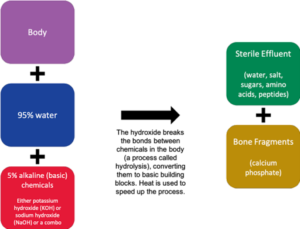In news– The body of Nobel Peace Prize winning Anglican archbishop and anti-apartheid campaigner Desmond Tutu underwent aquamation, a green alternative to traditional cremation methods, in Cape Town recently.
About Aquamation-
- Aquamation, or alkaline hydrolysis, is a process in which the body of the deceased is immersed for a few hours in a mixture of water and a strong alkali in a pressurized metal cylinder and heated to around 150 degree centigrade.
- The combination of gentle water flow, temperature and alkalinity accentuate the breakdown of the organic materials.
- It has been defined as “flameless cremation”.
- Considered to be an environmentally friendly way to dispose of a body, the process is also known as water cremation, green cremation or chemical cremation.

- The process leaves behind bone fragments and a neutral liquid called effluent.
- The effluent is sterile, and contains salts, sugars, amino acids and peptides.
- The decomposition that occurs in alkaline hydrolysis is the same as that which occurs during burial, just sped up dramatically by the chemicals.
- There is no tissue and no DNA left after the process completes.
- This effluent is discharged with all other wastewater, and is a welcome addition to the water systems.
- The process of aquamation uses energy which is five times less than fire.
- The process is a greener alternative as it uses significantly less fuel and has an overall lower carbon footprint than cremation.
- The process was developed and patented in 1888 by Amos Herbert Hanson, a farmer who was trying to develop an ingenious way to make fertilizer from animal carcasses.
- The first commercial system was installed at Albany Medical College in 1993 after which the process continued to be in use by hospitals and universities with donated body programmes.
- It was only in 2011 that the process was used in the funeral industry, at two funeral homes in Ohio and Florida, USA.
Further reading: https://journalsofindia.com/desmond-mpilo-tutu/
Source: The Indian Express
















